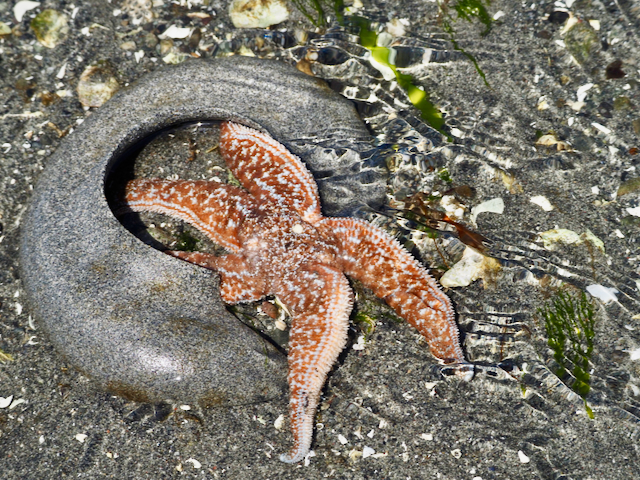PART 2
TOP: Frilled Dogwinkle (Nucella lamellosa)
This second in a four-part series on beach eggs will look at some unusual marine snail eggs, starting with the Frilled Dogwinkle (Nucella lamellosa). These honeycomb-like yellow eggs were the first marine eggs that caught my attention. Females come ashore in winter to lay their eggs together over a few months. Sometimes hundreds of these snails gather on one boulder at North Beach, ignoring what look to me like perfectly similar boulders nearby. Rather than individual eggs, this dogwinkle lays stalked, pointy egg capsules, each containing 20-80 eggs. Once the baby snails are released, the empty yellow capsules still clinging to the rock fade to dark brown.

Here’s a closer look at the egg capsules of the Frilled Dogwinkle (Nucella lamellosa) with the eggs inside. Some of these eggs become nourishment for their developing siblings, or “nurse eggs,” in their survival of the fittest. Frilled Dogwinkles are also known as Wrinkled Dogwinkles and Purple Dogwinkles. Why purple? Some interesting history about another Nucella species is that the purple dye that famously colored royal Roman robes was made from ground up shells of a Mediterranean Nucella. Apparently our local species doesn’t produce such a vibrant color.

A fun snail egg to spot is the Wide Lacuna (Lacuna vincta), whose tiny rings of eggs look just like… bagels! The center of this photo shows a rare sighting of the snail herself, whose spiral shell isn’t much bigger than the ring of eggs she’s in the process of laying. Here she laid them on blistered kelp, but more commonly I find them stuck to bright green eelgrass, where this snail often lives and finds diatoms to consume. These eggs are pastel green colors when fresh, then turn yellow when mature.

One of the most remarkable egg-layers is the Lewis’ Moon Snail (Neverita lewisii), named because consuming them helped Captain Meriwether Lewis survive a terrible winter when he finally reached the mouth of the Columbia River. This snail’s fist-sized body produces a round, firm “egg collar,” up to a foot diameter. It’s a layer of small eggs coated by jelly in the center, and covered on both sides with sand. The snail herself is rarely seen, as she burrows into the sand to find clams and other food, and emerges to lay her egg collar. Walk along the beach at Lagoon County Park on Indian Island at a minus tide in summer, and you’ll see dozens of egg collars, like this one beside a Mottled Star. When we organize Indian Island beach cleanups for the Port Townsend Marine Science Center, we always mention to volunteers that these egg collars are future snails, not plastic trash.

Our last gastropod is the Blister Glassy-Bubble (Haminoea vesicula), whose shell is completely covered by its soft body. One sunny summer day, my husband and I paddled our kayaks in clear, shallow water at Mats Mats Bay, and we came upon an eelgrass meadow covered in thousands of this snail’s yellow egg ribbons. During a summer minus tide, look for bright green eelgrass in a shallow tide pool in front of Chetzemoka Park. You may be lucky to spot the lacy yellow spirals attached to, and floating among, the eelgrass, appearing like an abstract painting. A golden brown 3/4” Blister Glassy-Bubble is in the center of this photo.
Stay tuned for Part 3 of Beach Eggs— fish eggs!









[…] more photos and stories of beach eggs, see Wendy’s Beach eggs: Part 1 and Beach eggs: Part 2. And watch for the final photo essay in this series, a grand finale with more remarkable beach […]
Have been loving your Beach Eggs series, Wendy! Thanks so much for sharing your beautiful photos, along with the great explanations!